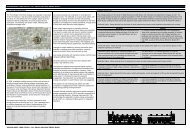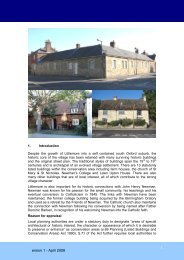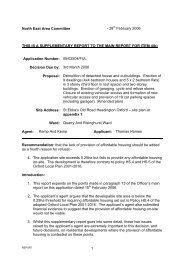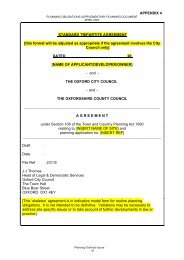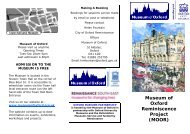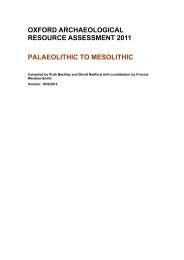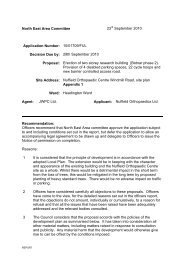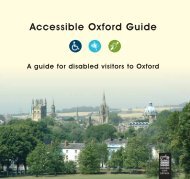Post-medieval Oxford - Oxford City Council
Post-medieval Oxford - Oxford City Council
Post-medieval Oxford - Oxford City Council
Create successful ePaper yourself
Turn your PDF publications into a flip-book with our unique Google optimized e-Paper software.
<strong>Post</strong>-<strong>medieval</strong> college wall surfacing and paintings<br />
A watching brief in the screens passage of Exeter College between the Dining Hall<br />
and the Servery recorded haired lime plaster, lath and stud work, wall plaster onto<br />
limestone blocks, black painted skirting and plastered limestone painted in a two tone<br />
brown design. The wall in question in the screens passage was believed to have<br />
been built as part of the hall in 1618. However, the observed detail could date from<br />
either the 1618 phase or renovation work in 1701-3 (Newell and Munby 2001).<br />
Further painted decoration was recorded during alterations to the Front Quad at<br />
Wadham College in 1997. Wadham is of particular interest because it a relatively<br />
complete and little altered college building of early 17th date with a plan that was<br />
influential on later college buildings (e.g. University and Oriel Colleges). Traces of<br />
painted decoration executed in blues, greens and cream colours, of swirling curlicues<br />
and possible foliage motifs were recorded around a fire place in the southern range<br />
of the Quadrangle (the JCR Room) (Newell and Munby 2001). The Brasenose<br />
painting has been mentioned above.<br />
<strong>Post</strong>-<strong>medieval</strong> halls<br />
A small number of halls remained even after the Elizabethan statute requiring<br />
students to live in colleges, though they were often virtually college annexes (e.g. St<br />
Mary Hall and Oriel; Magdalen Hall and College; Alban Hall and Merton College).<br />
New Inn Hall<br />
An academic hall, Trillock's Inn, was rebuilt in the 15th century and renamed New Inn<br />
Hall (Pantin 1959-60). It maintained this status until 1887, when it passed to Balliol<br />
College. It has since become part of St Peter's College. The buildings were recorded<br />
on Williams' map of <strong>Oxford</strong> (1733) and by the university surveyor in the early 19th<br />
century and further recording was carried out by Hurst before alterations (UAD 1384).<br />
The west range of Trillock's Inn was demolished and the east wing along New Inn<br />
Hall Street rebuilt, although a small fragment of a chimney remains visible on the<br />
street front (UAD 1545).<br />
St Edmund Hall<br />
St Edmund Hall became a college in 1957. It retains a sequence of 15th-20th century<br />
buildings (excluding the 12th century St Peter in the East used as a library).<br />
OXFORD ARCHAEOLOGICAL RESOURCE ASSESSMENT- POST MEDIEVAL<br />
51



